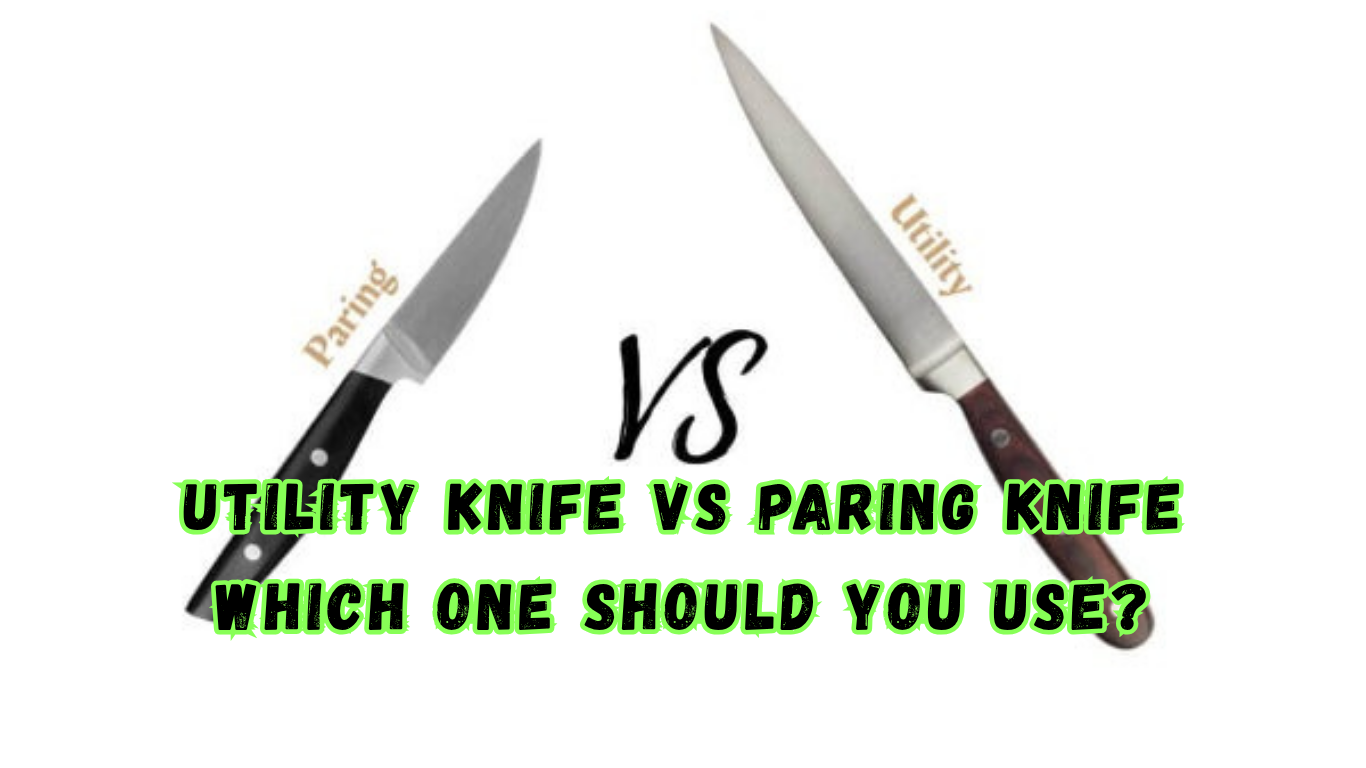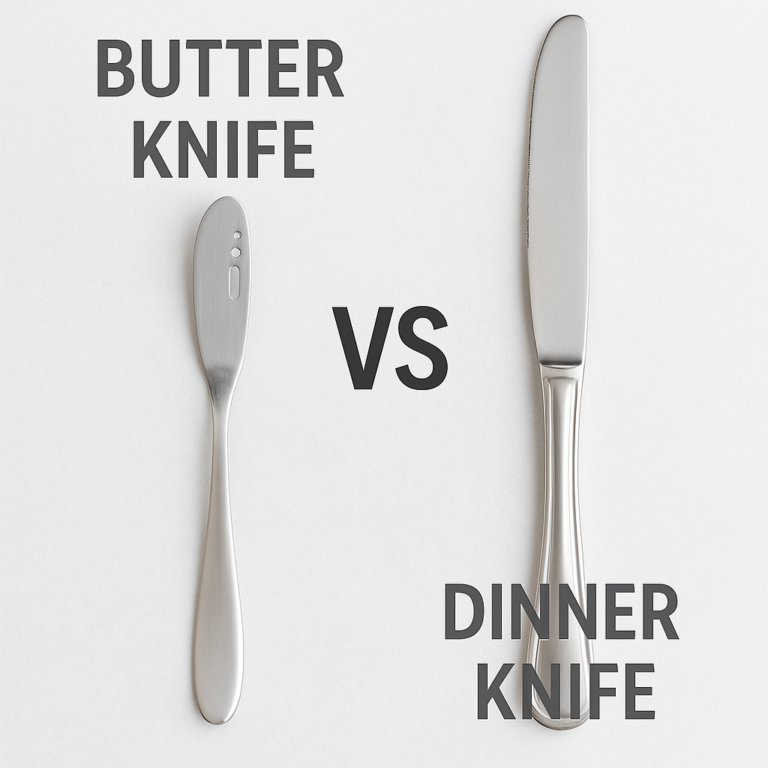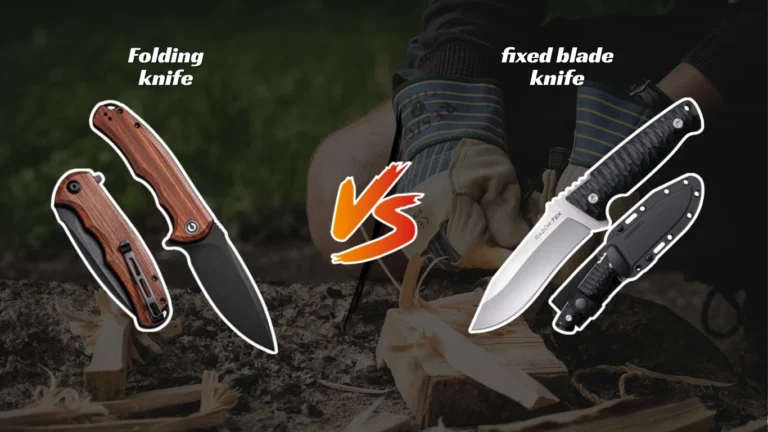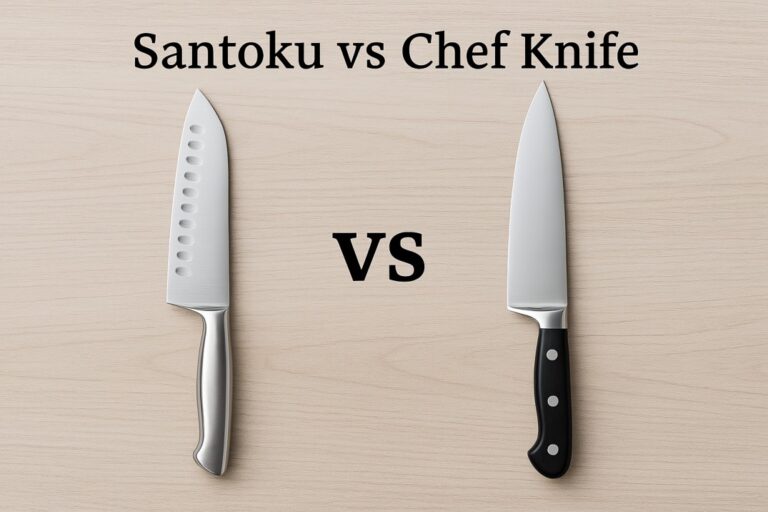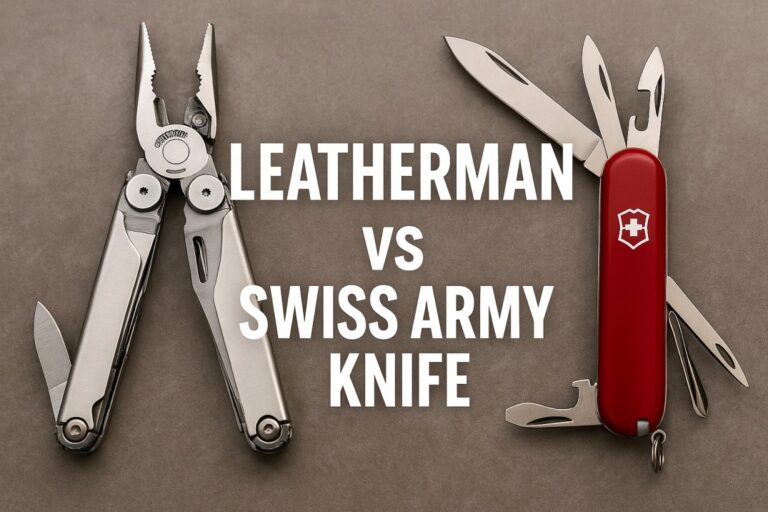Utility Knife Vs Paring Knife: Kitchen Essentials Unveiled
When you’re chopping, slicing, or dicing in the kitchen, having the right knife can make all the difference. But with so many options available, how do you choose the best one for your needs?
If you’ve ever found yourself staring at a utility knife and a paring knife, wondering which one to pick up, you’re not alone. These two kitchen tools might seem similar at first glance, but they each have distinct features and purposes.
Understanding these differences can elevate your cooking experience and make meal prep a breeze. So, what’s the best knife for your next culinary creation? Read on to discover which knife deserves a spot in your kitchen arsenal and why it can transform your cooking from good to gourmet.

Credit: www.flavorish.ai
Utility Knife Features
In the kitchen, choosing the right knife can make all the difference. The utility knife and paring knife often get compared. They both have unique features. This section explores the features of a utility knife. Discover what sets it apart. And why it might become your favorite kitchen tool.
Blade Length And Size
A utility knife usually has a blade length between 4 to 7 inches. This size makes it versatile. It fills the gap between a chef’s knife and a paring knife. It is large enough for slicing and small enough for peeling.
Blade Shape And Design
The blade often has a straight edge. Some models have a slight curve. This design aids in precision cuts. The pointed tip helps in piercing tasks. Perfect for cutting small fruits and vegetables.
Handle Comfort And Grip
Utility knives usually have ergonomic handles. They ensure a comfortable grip. This reduces hand fatigue. Even during extended use. Look for a non-slip material for added safety.
Material And Durability
Most utility knife blades are stainless steel. Some are carbon steel. Both offer durability and longevity. They resist rust and corrosion. This is crucial for everyday kitchen use.
Versatility In Use
Utility knives are versatile. They handle a variety of tasks. From slicing sandwiches to cutting herbs. They are a great all-rounder for daily kitchen chores.
| Feature | Description |
|---|---|
| Blade Length | 4 to 7 inches |
| Blade Shape | Straight or slightly curved |
| Handle Material | Ergonomic, non-slip |
| Blade Material | Stainless or carbon steel |
| Versatility | Multiple kitchen tasks |
Paring Knife Features
Choosing the right knife for your kitchen tasks can elevate your cooking experience. Utility knives and paring knives both have their unique attributes. While utility knives are versatile, paring knives shine in precision tasks. Understanding the features of a paring knife will help you select the right tool for intricate culinary jobs.
Blade Size And Shape
Paring knives typically have a blade length of 3 to 4 inches. This short blade allows for excellent control. The blade is usually straight or slightly curved, perfect for peeling and trimming. A pointed tip is ideal for delicate tasks like coring fruits.
Material And Construction
High-quality paring knives are often made from stainless steel or carbon steel. These materials ensure durability and sharpness. The construction is generally full tang, enhancing balance and strength. This robust build makes it reliable for various small tasks.
Handle Design
The handle is designed for comfort during extended use. Ergonomic handles reduce hand fatigue. Many paring knives feature non-slip grips, offering safety and precision. Some are crafted from wood, others from composite materials, catering to different preferences.
Versatile Uses
A paring knife is versatile in its application. Perfect for peeling, slicing, and trimming. Ideal for intricate tasks like deveining shrimp or hulling strawberries. Its precision makes it indispensable for garnishing dishes.
Paring knives require regular sharpening for optimal performance. Handwashing is recommended to preserve the blade quality. Proper storage prevents damage and maintains the edge. Investing in a knife block or sheath is advisable.
| Feature | Description |
|---|---|
| Blade Length | 3 to 4 inches for precision |
| Materials | Stainless or carbon steel |
| Handle | Ergonomic, non-slip |
| Uses | Peeling, slicing, garnishing |
Understanding these features will help you make an informed decision about adding a paring knife to your collection.
Primary Uses
Choosing between a utility knife and a paring knife often depends on their primary uses in the kitchen. Each knife serves distinct functions, making them essential for specific tasks. Understanding their applications helps in selecting the right tool for your culinary needs.
Utility Knife Applications
The utility knife is a versatile kitchen tool. It’s perfect for everyday tasks that don’t require a specialized knife. This knife is larger than a paring knife but smaller than a chef’s knife, making it ideal for intermediate tasks.
Its uses include:
- Slicing fruits and vegetables: Ideal for medium-sized produce like cucumbers and apples.
- Cutting sandwiches: Neatly slices through bread and fillings.
- Trimming meat: Handles small pieces of chicken and beef with precision.
- Peeling thick-skinned produce: Useful for peeling items like potatoes.
The utility knife’s size and sharpness make it adaptable. It’s often the go-to knife for quick kitchen tasks. Its versatility makes it a staple in many kitchens.
Paring Knife Applications
The paring knife excels in precision tasks. It’s small and sharp, designed for intricate work. Its primary uses revolve around peeling and detailed cutting.
Common applications include:
- Peeling fruits and vegetables: Perfect for apples, potatoes, and more.
- Trimming and slicing: Ideal for small produce items like garlic cloves.
- De-seeding fruits: Efficiently removes seeds from items like bell peppers.
- Creating garnishes: Great for detailed work with citrus peels.
The paring knife’s small size offers control and precision. It’s essential for tasks that require delicate handling. This knife is indispensable for detailed kitchen work.
Blade Design
Understanding the blade design of utility knives and paring knives is crucial for making the right choice in your kitchen. Both knives serve different purposes, and their blade designs reflect these roles. Whether you’re peeling an apple or slicing a sandwich, the design of the blade can affect efficiency and ease of use. Let’s explore how these two types of knives differ in their blade design.
Utility Knife Blade Types
Utility knives are versatile tools in any kitchen. Their blade design is crafted for general-purpose tasks. Utility knives typically have a blade length ranging from 4 to 7 inches. This makes them perfect for tasks that are too large for a paring knife but too small for a chef’s knife.
Here are some common utility knife blade types:
- Straight Edge: Ideal for slicing fruits, vegetables, and meats. Provides clean cuts and is easy to sharpen.
- Serrated Edge: Perfect for cutting through tougher surfaces like bread crusts or tomatoes. The serrated design grips and tears through without crushing.
- Granton Edge: Features indentations that create air pockets. This reduces friction and prevents food from sticking.
Let’s take a quick look at the pros and cons of each blade type:
| Blade Type | Pros | Cons |
|---|---|---|
| Straight Edge | Clean cuts, easy sharpening | Not ideal for hard crusts |
| Serrated Edge | Great for crusts and soft fruits | Difficult to sharpen |
| Granton Edge | Reduces sticking, less friction | Harder to maintain |
Paring Knife Blade Types
Paring knives are the masters of precision work. Their blade design is short and sharp, typically 2.5 to 4 inches in length. This makes them ideal for tasks like peeling, trimming, and intricate cutting.
Common paring knife blade types include:
- Spear Point: The most traditional design. Straight edge with a pointed tip for detailed work.
- Bird’s Beak: Curved blade resembling a bird’s beak. Excellent for peeling round fruits and vegetables.
- Sheep’s Foot: Straight edge with a rounded tip. Offers control for slicing and chopping.
Consider these aspects when choosing a paring knife:
- Spear Point: Best for precision tasks. Easy to control and maneuver.
- Bird’s Beak: Great for decorative cuts. Ideal for garnishing.
- Sheep’s Foot: Provides safety with a rounded tip. Perfect for beginners.
Paring knives, with their precise blade designs, become indispensable for detailed kitchen tasks. Their small size offers control, making them essential for any chef.
Handle And Grip
When choosing between a utility knife and a paring knife, the handle and grip are key factors. A comfortable handle ensures precise cuts and reduces hand strain. Different handle styles offer various advantages for kitchen tasks. Let’s explore how utility and paring knives differ in this aspect.
Utility Knife Handle Styles
Utility knives often feature diverse handle styles to suit different needs. Ergonomic designs are common. They fit the hand well, providing comfort during prolonged use. Some handles are textured or have ridges. This enhances grip, especially in wet conditions.
Material choices for utility knife handles include:
- Plastic: Lightweight and affordable. Offers basic grip.
- Rubber: Provides a comfortable and non-slip grip.
- Wood: Offers a classic look. May require more care.
- Metal: Durable and sturdy. Can be heavier.
Each material has its pros and cons. Plastic is easy to clean but less durable. Rubber feels great but may wear over time. Wood is aesthetically pleasing but needs maintenance. Metal is long-lasting but might be heavy.
Consider the handle style that best fits your cutting needs. If comfort is a priority, opt for ergonomic or rubber handles. For durability, metal or sturdy plastic are ideal choices.
Paring Knife Handle Styles
Paring knives often feature smaller, more slender handles. This allows for precise control. Handle designs vary greatly, catering to different preferences and tasks. Many paring knife handles are designed for agility. They help in tasks like peeling and trimming.
Common materials for paring knife handles include:
- Wood: Offers a traditional feel. Requires regular care.
- Composite: Durable and resistant to moisture.
- Plastic: Lightweight and easy to maintain.
- Metal: Provides a solid grip. Can add weight.
Paring knives benefit from handles that balance size with control. Wood is beloved for its warmth but needs upkeep. Composite is modern and low-maintenance. Plastic is practical yet less robust. Metal ensures a firm grip but may increase weight.
Choose a paring knife handle that feels natural in your hand. Look for a style that complements the knife’s use. For nimble tasks, a lightweight handle is beneficial. For durability, a composite or metal handle is wise.

Credit: finoak.com
Maintenance And Care
Maintaining kitchen knives is crucial for their longevity and performance. A utility knife and a paring knife, though small, require specific care to keep them sharp and effective. While both knives have their unique uses, their maintenance routines share some similarities. Understanding these routines ensures that your knives remain your trusty kitchen companions.
How To Clean A Utility Knife
Cleaning a utility knife involves more than just a quick rinse. Always wash the knife by hand using warm, soapy water immediately after use. Avoid dishwashers as they can dull the blade and damage the handle.
- Use a soft sponge to prevent scratches.
- Dry the knife thoroughly with a clean towel.
Sharpening A Utility Knife
Regular sharpening keeps a utility knife in top shape. A sharp blade makes cutting safer and more efficient.
- Use a honing rod for minor touch-ups.
- Employ a whetstone for deeper sharpening.
- Sharpen at a 20-degree angle for best results.
How To Clean A Paring Knife
Paring knives need gentle care. Similar to utility knives, they should be hand washed promptly after use. This prevents rust and preserves sharpness.
- Avoid abrasive scrubbers.
- Ensure the knife is completely dry before storage.
Sharpening A Paring Knife
Sharpening a paring knife requires precision. A sharp paring knife is essential for intricate tasks like peeling and mincing.
| Tool | Frequency |
|---|---|
| Honing Rod | Weekly |
| Whetstone | Monthly |
Storing Your Knives
Proper storage extends the life of your knives. Keep them in a knife block or on a magnetic strip to avoid damage.
- Store knives separately to prevent dulling.
- Avoid crowded drawers.
Safety Considerations
In the culinary world, choosing the right knife can make all the difference. Two popular options are the utility knife and the paring knife. Each serves its unique purpose, but safety remains a top priority. Understanding their safety considerations can help prevent accidents in the kitchen. Explore these aspects to ensure a safe cooking environment.
Safety Features Of Utility Knife
Utility knives often feature a sturdy handle, providing a secure grip. This minimizes the risk of slipping. Their blades are usually mid-sized, offering good control while cutting. Balanced weight distribution ensures smoother operations.
- Non-slip grips: Often equipped with textured handles.
- Blade guard: Protects the blade when not in use.
- Locking mechanism: Prevents accidental blade exposure.
Safety Features Of Paring Knife
Paring knives are designed for precision tasks. Their small size allows better maneuverability. A sharper blade requires careful handling. Ensuring safe use involves maintaining focus during intricate cuts.
- Ergonomic handle: Fits comfortably in hand for steady control.
- Short blade length: Reduces risk during detailed tasks.
- Finger guard: Some models include protection for fingers.
Comparative Safety Analysis
| Feature | Utility Knife | Paring Knife |
|---|---|---|
| Grip | Non-slip texture | Ergonomic design |
| Blade Size | Mid-sized | Short |
| Special Features | Blade guard, locking mechanism | Finger guard |
Tips For Safe Use
Using knives safely involves proper techniques. Keep blades sharp to reduce effort and prevent slipping. Focus on the task at hand to avoid distractions. Store knives properly after use to prevent accidents.
- Keep knives dry to maintain grip.
- Use cutting boards to stabilize ingredients.
- Practice safe cutting techniques to minimize risk.
Cost Comparison
Choosing the right knife for your kitchen can feel overwhelming. Among the popular choices are utility knives and paring knives. Each serves a unique purpose, but understanding their cost differences is crucial. Let’s explore the cost comparison between these two essential kitchen tools.
Utility Knife Cost Analysis
Utility knives are versatile and often used for slicing meats and chopping vegetables. They come in various sizes and materials, affecting the price. Here’s a breakdown:
- Budget Options: Basic models can start as low as $10. Ideal for casual cooks.
- Mid-Range: Stainless steel or ceramic versions range from $20 to $50.
- Premium: High-end knives with ergonomic handles and superior materials can cost $100 or more.
Utility knives offer a broad price range, catering to different needs and budgets.
Paring Knife Cost Analysis
Paring knives are perfect for peeling and intricate tasks. Their cost varies, influenced by design and material:
- Economical Options: Basic paring knives might be available for under $10.
- Mid-Tier Choices: Quality models range from $20 to $40. Often stainless steel.
- Luxury Tier: High-quality, designer paring knives may exceed $80.
Paring knives often cost less than utility knives, making them accessible for many cooks.
Comparative Cost Table
| Knife Type | Budget | Mid-Range | Premium |
|---|---|---|---|
| Utility Knife | $10 – $20 | $20 – $50 | $100+ |
| Paring Knife | $5 – $10 | $20 – $40 | $80+ |
Understanding the cost helps make an informed decision. Choose based on your cooking needs and budget.
Choosing The Right Knife
Choosing the right knife for your kitchen tasks can make cooking more enjoyable and efficient. Two popular options are the utility knife and the paring knife. Both are versatile, yet each serves specific functions. Deciding which one fits your needs best depends on how you use them. Let’s explore how these knives can fit into your kitchen routine, whether at home or in a professional setting.
For Home Use
Home cooks often seek tools that offer convenience and versatility. The utility knife is a great choice for everyday tasks. It is larger than a paring knife, typically measuring around 5 to 7 inches. This makes it suitable for slicing fruits, vegetables, and even small cuts of meat. Its size provides a good balance between a chef’s knife and a paring knife, making it a must-have in any home kitchen.
On the other hand, the paring knife is perfect for tasks that require precision. With a blade length of about 3 to 4 inches, it excels in peeling, trimming, and detailed cutting. Ideal for small fruits and vegetables, it allows for intricate tasks like deveining shrimp and removing seeds.
Here’s a quick comparison to help you decide:
| Feature | Utility Knife | Paring Knife |
|---|---|---|
| Blade Length | 5-7 inches | 3-4 inches |
| Best For | Slicing, dicing | Peeling, trimming |
| Flexibility | Medium | High |
For home use, consider the types of meals you prepare. If you often work with small, delicate ingredients, a paring knife is essential. For a mix of tasks, a utility knife provides versatility.
For Professional Use
Professional chefs require tools that offer precision and durability. The utility knife is favored for its adaptability in a fast-paced kitchen. It handles a variety of tasks, from cutting sandwiches to slicing vegetables. Its moderate size makes it easy to maneuver, offering a balance between speed and accuracy.
In a professional setting, the paring knife is crucial for intricate tasks. Chefs use it for peeling, deveining, and making decorative cuts. Its smaller size allows for control and precision, which is vital in professional kitchens.
Consider these factors for professional use:
- Durability: Choose high-quality materials for long-lasting performance.
- Ergonomics: Comfort during long use is important.
- Maintenance: Regular sharpening keeps blades effective.
In professional kitchens, the choice between a utility knife and a paring knife depends on specific needs. If precision tasks dominate, a paring knife is essential. For versatility, rely on a utility knife.
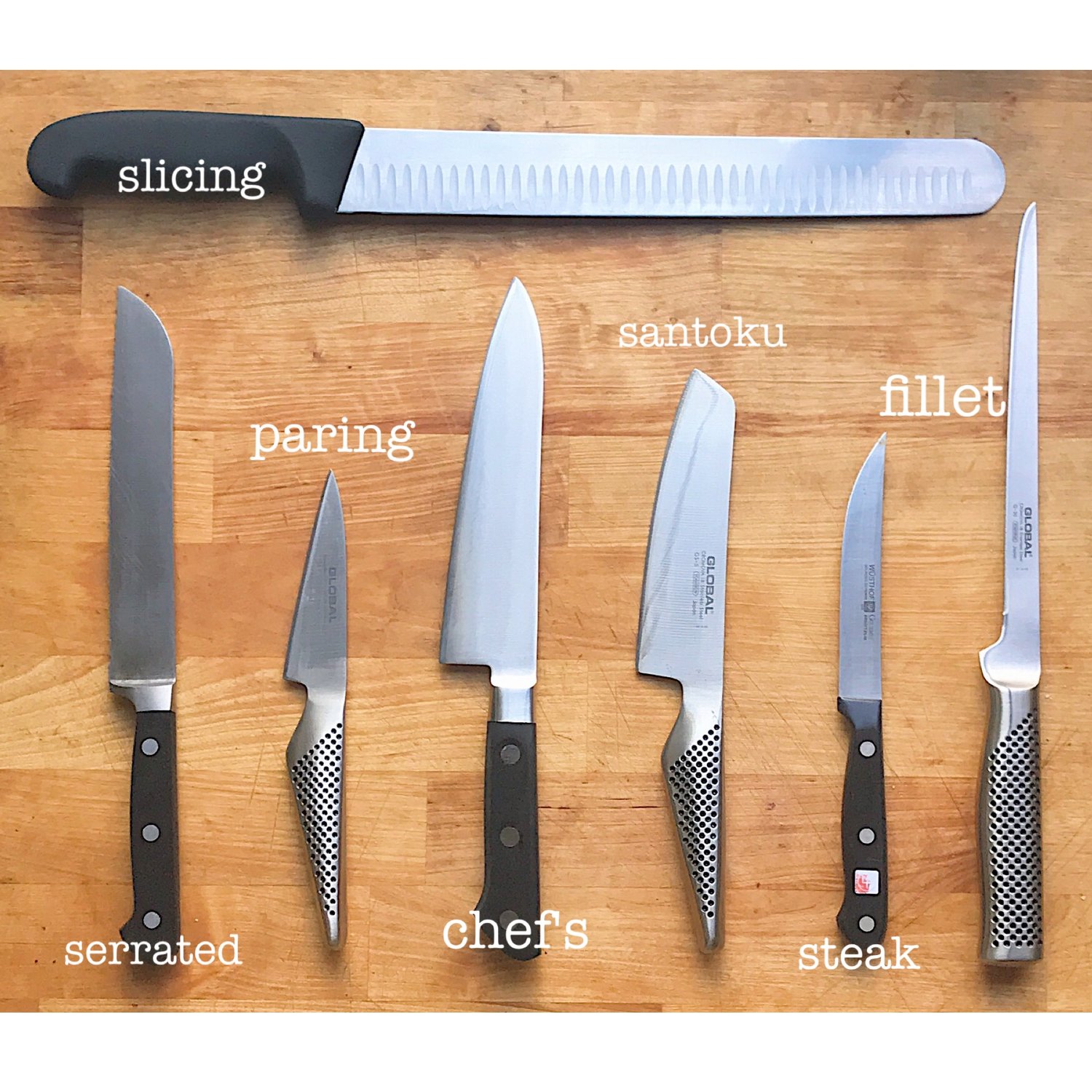
Credit: newfoodtuesdayz.com
Frequently Asked Questions
What Is A Utility Knife Used For?
A utility knife is versatile. Great for slicing meats, chopping veggies, and cutting sandwiches.
How Does A Paring Knife Differ?
A paring knife is small and sharp. Ideal for peeling fruits and precise cuts.
Which Knife Is Better For Beginners?
For beginners, a utility knife is recommended. It’s multipurpose and easy to handle.
Can I Use A Paring Knife To Cut Meat?
Paring knives aren’t ideal for cutting meat. Better for small tasks like peeling and trimming.
Is A Utility Knife Good For Peeling?
Utility knives can peel, but paring knives are better. More precision and control for peeling tasks.
Conclusion
Choosing between a utility knife and a paring knife depends on your needs. Utility knives are versatile for larger tasks. Paring knives excel at precision work, like peeling fruits. Both knives have unique strengths. Think about what you cook most often.
This helps in deciding which knife suits your kitchen best. Investing in quality knives enhances your cooking experience. Remember, proper care extends the life of your knives. Keep them sharp and clean. With the right knife, cooking becomes easier and more enjoyable.
Happy cooking!
Related Post: Best Japanese Chef Knives Under $100 in 2025: Expert Reviews

